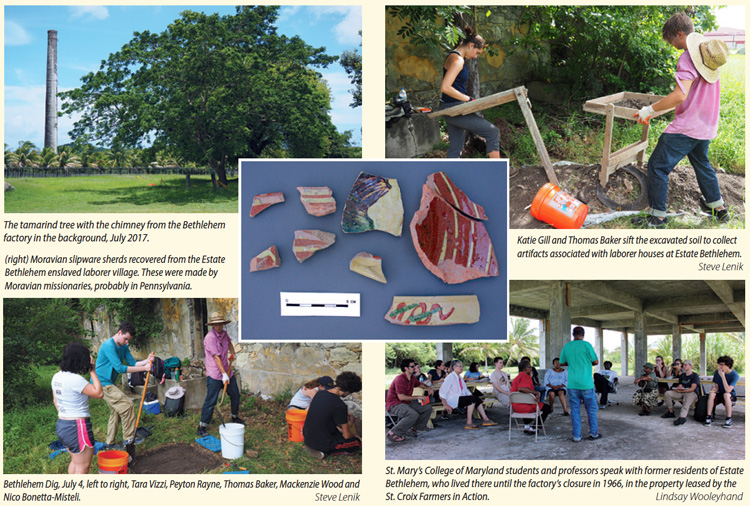 by Steve Lenik, PhD, St. Mary’s College of Maryland
by Steve Lenik, PhD, St. Mary’s College of Maryland
After St. Croix became a colony of Denmark in 1733, much of the island’s economy was dominated by industrial production of sugar cane to make sugar, molasses, and rum, until sugar production ended in the 1960s. For labor the planters relied on the slave trade and a brutal system that enslaved and oppressed the Africans who built the plantations and grew sugar cane. After Emancipation in 1848, free laborers received low wages to cultivate sugar, which continued after transfer to the United States in 1917. This agricultural past, shapes the Crucian landscape today, not only in the factories, windmills, and estate houses that remain but also the place names, road system, and property boundaries. Less visible are laborers’ homes and cemeteries, though some can still be found.
The sugar plantation at Estate Lower Bethlehem Old Works, located in the center of St. Croix north of Centerline Road, encapsulates Crucian history from the 1730s until it shut down in 1966. Later, the Government of the Virgin Islands took over the property. Ownership passed from the Crown to Danish families and American corporations, including the U.S. Government. By the mid-twentieth century the Bethlehem Central Factory employed over 2,000 people, many of whom lived with their families on site or nearby. Today the former factory is leased to Farmers In Action, Inc., with an adjacent parcel leased to the Virgin Islands National Guard (VING). When the VING began developing the site in the 1980s, it coordinated with the Virgin Islands State Historic Preservation Office (VISHPO) to comply with local and federal laws that protect archaeological resources.
In 1997, National Park Service archaeologists had identified a few possible human burials near a large tamarind tree. As the VING planned to build a new headquarters, archaeologists from the VISHPO returned to explore the area in 2002. Carefully scraping the ground with shovels and hand trowels they traced the outline of grave shafts without disturbing the interred individuals, revealing a “lost” cemetery with over 33 human burials. This is an enslaved African cemetery, based on the associated artifacts and a 1779 map showing it would have been located in the slave village. This is a significant find. Usually, slave cemeteries are discovered accidentally through damage by construction projects. In this case, individual burials are clearly visible and they are intact. Additionally, over 70 features associated with the village preserve evidence of the lives of enslaved Africans. Archaeologists recovered fragments of hand-made ceramic pots and imported ceramic vessels, spoons, knives, beads, clay smoking pipes, and other objects. As a result, the VING headquarters was built elsewhere, protecting the cemetery and village near the tamarind.
Over the past fifteen years, it has remained a challenge to make this site accessible to Crucians and other visitors, with limited funding. Moreover, so much about life at Bethlehem can still be learned, as new archival records become available. Members of the last generation who lived and worked at Bethlehem preserve memories of St. Croix’s “third town,” and some oral histories had been published. In 2017, research resumed at the cemetery and village, with ten students from St. Mary’s College of Maryland directed by the author, who worked on the 2002 project, and Professor Iris Carter Ford, a cultural anthropologist, who did archive research, ethnographic interviews, and archaeology. Interviews recorded details of life at Bethlehem, documenting who had lived in houses, leisure time activities, foods people ate, and plants and trees they used. Excavations at the front of a stone and mortar labor house inhabited in the nineteenth and twentieth centuries reveal laborers’ use of social space. Archival records we found list enslaved persons who had died there. In the future, these findings will help the VING to interpret the site and make it available to visitors.
Anyone with further information about Bethlehem may contact the author at [email protected]
